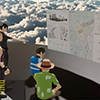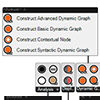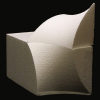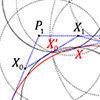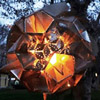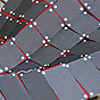Below is the first paper of my son, Mete Yazar. It is about a mathematical and geometric exercise of calculating the surface area of an arbitrary shape (a classical guitar’s body panel). He did a good job in utilizing Bezier/de Casteljau curves and generating the parametric equations of the piecewise curve. I helped him to validate the results by using rhinoceros CAD software. Therefore, it seems that his calculations are […]
Posts categorized under Publications
This is the latest reel video of the Online Virtual Studio (OVS) project. We conducted it together with Oğulcan Üneşi and Serkan Uysal since 2022. We tried to develop a tool for online and blended education in architectural studios. The tool has specific features tailored for design studios. İstanbul Bilgi University Scientific Research Fund partially supported this project. This video showcases the latest toolset OVS provided. The tool takes some […]
There are cognitive, technological, and pedagogical ideas and experimental studies on architectural design education in virtual environments. In the existing literature; new software tools were developed, add-ons to existing software were developed, or software prototypes were developed and tested on various platforms such as game engines. In the distance education model, currently, there is no stand-alone software, specifically developed for the needs of architectural design studios. Similarly, there is no […]
This paper investigates the integration of robotic fabrication into first-year undergraduate design education, particularly in a basic design studio. Traditionally, robotic technologies are not introduced at this level due to perceived skill gaps among novice students. The study demonstrates the potential and strategies for incorporating robotic arms into early design education through an experiment conducted at Istanbul Bilgi University. The experiment involved 32 students from various design disciplines, divided into […]
Architectural design, as a cognitive activity, has always been fed by architectural knowledge based onpractice and theory, and it has been questioned how creative and generative design processes canbenefit from scientific methods. Therefore, through inquiry and experimentation, the architect develops his or her ideas, constructs and analyzes the space, and continuously improves it. However, this is asubjective process. There are design tools and methods that provide objective criteria for theassessment […]
This is the new paper with Meryem Nurefşan Yabanigül, published at Automation in Construction. It is also Meryem’s master’s thesis. This study is about testing the production of curved surfaces with non-linear robotic hotwire cutting and shape memory alloys. Below is the abstract of it: Robotic arms are being used by construction firms and schools of architecture around the world in design/build research and material studies. Some of these studies […]
This is a new paper published in Nexus Network Journal. I tried to implement euclidean constructions by compass in the approximation of famous parametric curves; Bézier curves, and B-Splines. Then, I created the algorithms to calculate the number of steps on a compass-only construction of Bézier curves. I developed a simple Python script to simulate the geometric constructions. However, I have been studying this topic for nearly four years. In […]
As the design of free-form architectural surfaces becomes easier, questioning and foreseeing the feasibility of the construction of these surfaces becomes important. Such an inquiry requires sufficient knowledge of architectural geometry besides the knowledge of materials and structural systems. In this article, we present a preliminary example of a guide. It supports the design and production process of building surfaces with different geometric properties is presented. This guide aims to […]
This paper covers ongoing research titled “Growing an Architectural System”. It is an interdisciplinary work relating permaculture studies with computational design and production technologies. It includes testing some issues of performance via full-scale prototypes. Growing Pots is the first study we will mention in the paper. It is about the design of a micro-permaculture system and 3d printed products realized by students of an elective course. On the other hand, […]
In the first-year Computation Based Basic Design studio at İstanbul Bilgi University, the aim is to help students understand that design, due to its prevalent relational nature incorporates different forms of reasoning as indispensable constituents within the creative process (Yalınay Çinici, 2013). The studio integrates the 1:1 scale construction via computational thinking which consists of geometric relations, material computation/performance, and CAD/CAM technologies. The aim of the studio is to develop an awareness of immediate or far surroundings […]
Here is the abstract of my last publication in the International Journal of Architectural Computing. Parquet Deformations is an architectural studio exercise of William Huff in the 1960s. It aims to improve students’ reasoning of spatiotemporal variation by utilizing sequential shape-shifting of patterns. This article examines the outcomes of this educational research from the perspective of design computing. A multilayered reading about the exercise will reveal its historical, theoretical, and artistic backgrounds. Then […]
Scientific publications are expected to relate to all areas of science they sprawl. For this, the scientific publication is associated with several keywords that are thought to be related. For proper access to scientific publications in literature research, keyword assignment is as important as the publication title. This study aimed to map the usage patterns of the concepts related to the field of digital design research through keyword analysis. The […]
This is a great site, explaining very familiar concepts of dataflow diagrams for designers firsthand. Leveling is an interesting chapter there, I’m not sure if it completely fits with the use of “Clusters” in Grasshopper but it is obvious that the complex systems should be well organized not only to be perceptually “better” ones but also to develop a way to use parts of definitions again and again in different situations. […]
Another Turkish translation from my Ph.D. The paper is titled “CAD Smart Objects: Potentials and Limitations”, presented by Magdy Ibrahim, Robert Krawczyk, and George Shcipporeit at the 21st eCAADe Symposium in 2003. It is a brief introduction to today’s CAD and BIM concepts. You can find this paper in CuminCAD’s database. Below is the Turkish version, which I translated in 2005: CAD SMART OBJECTS: POTENTIALS AND LIMITATIONSMagdy Ibrahim, Robert Krawczyk, […]
This is my Turkish translation of the 1997 article by Charles Jencks, “Nonlinear Architecture: New Science = New Architecture?”. Very short but the cult text explains the emergence of a new technology-based architecture. Although very old, it is still an up-to-date discussion for computational design research. NON-LINEAR ARCHITECTURE: NEW SCIENCE = NEW ARCHITECTURE ? Charles Jencks Yüz yıldan beri pekçok mimar yeni oluşan yaşam koşullarının yeni bir mimarlığı doğuracağını söylemişlerdir. […]
Here is a good brief explanation by Mark Garcia on how patterns re-emerged in the digital age after Modernism and Postmodernism. …In the 1980s and 1990s, Postmodernist patterns predominated, and especially those of Robert Venturi, Rem Koolhaas, Stan Allen and Sanford Kwinter (fields), along with historicist, folding, sprawl, cross-programming, high-density/proximity, non-places and other Deconstructivist and high-tech patterns. In 1992, Henri Lefebvre’s last book Rhythmanalysis: Space, Time and Everyday Life was […]
Here is a phrase from Deleuze’s famous article “Difference and Repetition”. It clarifies my mind while thinking about patterns, boundaries, rules, and most importantly, the idea and techniques of deformation in contemporary architectural geometry. … On the other hand, generality belongs to the order of laws. However, law determines only the resemblance of the subjects ruled by it, along with their equivalence to terms which it designates. Far from grounding […]
Here is a simple explanation of the famous Euclidean Constructions: Why didn’t Euclid just measure things with a ruler and calculate lengths? For example, one of the basic constructions is bisecting a line (dividing it into two equal parts). Why not just measure it with a ruler and divide by two?One theory is the the Greeks could not easily do arithmetic. They had only whole numbers, no zero, and no […]
This is our eCAADe paper with Fulya Akipek, explaining our 2013 Workshop series called “Infections”. Contemporary trend of the computational design education is grounded on an integration of domains such as fabrication technologies, material studies, and generative techniques. This requires not only an intuitive handling on digital tools and methods, but also an experience on material and production constraints simultaneously. Patterning emphasizes a material shift in the generative side of […]
This paper presents the beginnings of my journey into architectural education, presented at Yıldız Technical University Architectural Education Symposium 2007, together with YTU/CADU staff; Ela Çil, Birgül Çolakoğlu, Meral Erdoğan, Fulya Akipek, Oya Pakdil, and Şebnem Yalınay. It includes different exercises from various studio instructors, all motivated by contemporary computational design theory. This was one of the milestones in the first year of education of a computation-based studio in Turkey, […]


